Instrumentation For All Phases Of Drug Development

Orbit Mini
The Orbit mini contains a built-in, miniaturized four-channel amplifier, allowing low noise recordings at high bandwidth without the need for any additional equipment – you could virtually conduct experiments while traveling by train!
Due to the unique design of the Orbit mini, the measurement chamber temperature can be actively controlled without additional noise generation.
The complete Orbit mini platform consists of the main recording unit with a built-in four channel amplifier (Elements S.R.L.), and an optional computer-controlled environmental control unit for active cooling and heating of the recording chamber. Ionera's MECA 4 disposable recording chips are used for manual painting and recording of four artificial lipid bilayers in parallel.

Orbit 16 TC
Nanion's Orbit 16 TC platform takes the pain out of bilayer painting and subsequent recordings as it enables fast and successful data generation thanks to the rapid automated formation of 16 bilayers at once and their subsequent fully parallel recording.
The Orbit 16 TC is equipped with a dedicated low-noise 16-channel amplifier (Elements S.R.L.) enabling the convenient fully parallel recording of 16 bilayers at the highest bandwidths and supreme signal-to-noise ratios.
The Orbit 16 TC is explicitly designed to meet the special requirements of high-throughput experiments on artificial bilayers at freely definable temperatures between 5 – 50 °C. The use of Ionera’s MECA (microelectrode cavity array) 16 TC chip technology combined with a built-in state-of-the-art low noise e16n amplifier (Elements S.R.L.) enables the fully parallel recording of 16 separate lipid bilayers at bandwidths up to 100 kHz at excellent signal-to-noise ratios.
The automated generation of 16 separate lipid bilayers by the push of a button as well as its small overall footprint maximizes the system’s everyday usability while drastically increasing the success rate and decreasing the overall time needed for data generation. Easy-to-learn and to-use data acquisition and immediate data validation via an online analysis feature are the hallmarks of the Orbit 16 TC’s tailor-made EDR4 software.

Port-a-Patch
The Port-a-Patch is a turn-key miniaturized patch clamp system enabling the user to rapidly generate high quality data, regardless of experience. This makes it ideal as an easy-to-use tool for learning patch clamp electrophysiology. Behind its small and compact appearance lies sophisticated technology, producing high-quality measurements with giga-seals and high success rates in most common recording configurations. Its strength and flexibility are found in multiple add-ons, providing the user with a powerful tool for ion channel research.
Using the Port-a-Patch is straightforward and easy – the user simply adds solutions and cells onto the disposable recording chip, where a cell is automatically captured and sealed by suction using a computer controlled pump. A microscope or micro-manipulator are not required.
Add-Ons such as the Internal Perfusion and temperature-controlled External Perfusion, as well as the ability to conduct current clamp and bilayer experiments, broaden the range of possible experiments for scientific research immensely.
The Port-a-Patch system is comprised of the Port-a-Patch recording unit, a Suction Control unit, a HEKA amplifier and a computer. If an amplifier is already available, this can be integrated with the Port-a-Patch system in most cases. Further add-ons are available for specific assays as e.g. microscope slides, temperature control, automated perfusion systems, pressure control and light activation.
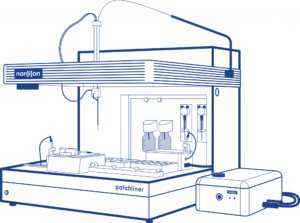
Patchliner
The Patchliner is versatile yet robust, ideal for basic research of ion channel biophysics and mechanisms of action, sophisticated assays such as heat activation, right through to routine assays such as safety screening of hERG or other cardiac ion channels in accordance with the CiPA initiative. The Patchliner is a medium throughput automated patch clamp system which comes as a 4 or 8 channel version. Experimental protocols are programmed using the PatchControlHT software which controls the Tecan robot for addition of solutions, cells and compounds, and controls the PatchMaster software for data acquisition. NPC-16 chips, the consumable for the Patchliner, can be loaded on the chip wagon and the instrument can run unattended for 48 recordings. The Patchliner is supplied as a complete system including Tecan pipetting robot, HEKA EPC10 amplifiers, NPC-16 chips, Reagent starter kit and all the required software. Add-ons for Temperature control, Cooled CellHotel and dynamic clamp (Dynamite8) are also available to expand the experimental possibilities. Our dedicated team of electrophysiologists and engineers are committed to continuous in-house assay development, software and hardware advancements, ensuring fast and custom-tailored solutions for your assay demands.
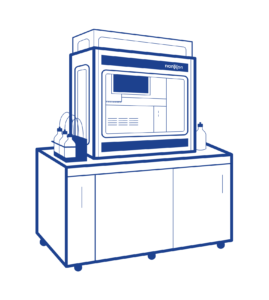
SyncroPatch 384
The SyncroPatch 384 is an automated patch clamp instrument with 384 recording channels incorporated into a state-of-art liquid handling robot. It can be used for screening large compound libraries but also for smaller screens and assay development using the 32-well mode of operation. This allows the instrument to be literally turned into a lower throughput instrument, using a fraction of the chip and pipetting head in multiples of 32 wells. The rest of the chip can be used over several days which takes further advantage of the economical price of the NPC-384 chip. The SyncroPatch 384 also includes a sophisticated temperature control which can cool as well as heat, this can be used to maintain a constant temperature or to activate cold-activated ion channels. The SyncroPatch 384 can be used in all stages of drug discovery, from hit discovery through lead optimization to safety pharmacology, and can also be used for complex biophysical analysis of ion channels in academic research. The SyncroPatch 384 is supplied as a complete system including the Biomek i5 pipetting robot, Tecella amplifier with 384 channels, NPC-384 chips, Reagent starter kit and all the required software. Temperature control, Cooled CellHotel and current clamp are all provided as standard.
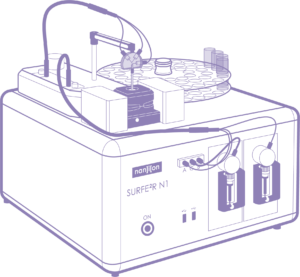
SURFE²R N1
The technology employs solid supported membrane (SSM) -based electrophysiology which was established in the late 1990s. The reusable sensors contain a gold-coating on which the SSM is formed in a quick pipetting process. Then the sample containing your transporter of interest is added on top to physically adsorb to the SSM. Any kind of membrane preparation containing the protein of interest can be used for measurements, e.g. membrane vesicles after cell disruption or proteoliposomes after reconstitution of purified proteins. These samples can be stored frozen for months and years. Therefore no running cell culture lab is required. The key to SSM-based electrophysiology is the exchange of solutions to provide the substrate or ligand and activate the transporter. The following charge translocation is detected and can be analyzed. Due to the high stability of the SSM up to one hundred sequential measurements can be performed on the same sample. This allows for determination of parameters such as EC50 or IC50. Since the time resolution of solution exchange is state-of-the-art, not only slow transport can be measured, but also fast binding reactions can be assayed and rate constants can be determined.
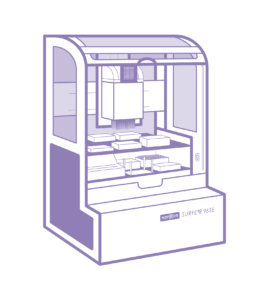
SURFE²R 96SE
Just like the SURFE2R N1, the SURFE2R 96SE employs solid supported membrane (SSM)-based electrophysiology to resolve small currents of transporters and pumps but elevates the throughput to the next level by parallelization of 96 measurements. The transporter samples are added to gold-coated sensors in a standard 96 well-plate format. To further reduce the user's workload, most sensor coating steps can be done by the SURFE2R 96SE itself. Any substrate can be added to activate the transporter. The resulting transport or binding currents will be detected and analyzed accordingly. The process from sensor preparation and measurement to data analysis is fully automated. The SURFE2R 96SE is preferred over the SURFE2R N1 when a high throughput environment is needed. This is the case, e.g. for compound or transporter screening projects. The SURFE2R 96SE is also suitable to increase throughput for basic research. Data generation is approximately 100 times faster compared to the SURFE2R N1.
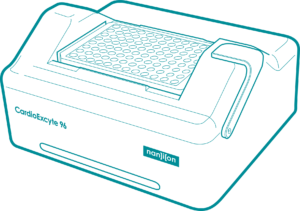
CardioExcyte 96
With embedded electronics and sophisticated sensor technology integrated into the well-plate-based consumables, the CardioExcyte 96 is a turn-key system for efficient impedance and extracellular field potential measurements. The CardioExcyte 96 package includes an Incubation System which makes the system independent of an incubator. The system is placed on the bench top with maintained control over temperature, gas mix, and humidity. Efficiency and ease of use are facilitated by an outstanding software package for data handling and export - an essential part of the CardioExcyte 96 system. The system has been validated with stem cell-derived cardiomyocytes from all major stem cell providers, as monolayers or beating 3D-clusters, as well as with cell lines (hepatocyte-like cells, cancer cells, etc.) for cytotoxicity studies.
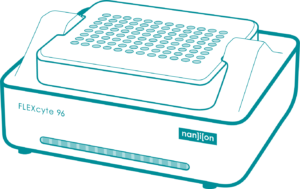
FLEXcyte 96
The FLEXcyte 96 brings in vitro contraction force measurements of cardiac cells to a new dimension. By using a well-defined, flexible substrate for cardiac cells, the system leverages maturity and mature responses of stem cell-derived cardiomyocytes to pharmacological compounds in a higher throughput format. In the 96-well plate, the cells adhere as monolayers on the flexible substrates and the contractility of the synchronized cell layers is recorded. This unique technology allows for recordings in a native-like environment close to the mechanical conditions of the heart. The FLEXcyte 96 is a turn-key system for structural and functional contraction force recordings in cardiotoxicity, safety and efficacy screening, and basic research. With less than 10 μm in thickness and sophisticated surface modification, the polydimethylsiloxane (PDMS) membranes of the FLEXcyte 96 disposable plates offer physiological elasticity of native human heart tissue and strong mechanical support. While being deflected by the weight of the culture medium, rhythmic contraction of the cardiomyocytes lifts the membranes in the 96-well upwards. By measuring the changes in deflection, mechanical stress can be calculated. The system has been validated with stem cell-derived cardiomyocytes from several providers (Ncardia, FUJIFILM Cellular Dynamics, Inc. (FCDI), Axol and NEXEL). Human induced pluripotent stem cell-derived cardiomyocytes (hiPSC- CMs) display positive inotropic responses, no additional stimulation of “cell maturation” is necessary. Cardiac contraction force can also be measured on patient-derived cells. No subtleties of cytotoxic responses are missed, and measuring contractile forces (mN/mm2) on heart muscle cells for safety, efficacy, and toxicity investigations in both chronic and acute time frames are performed reliably. The FLEXcyte 96 is a fully automated device, records from 96 wells in parallel.
Want to know more?
Do you wish to reach out for more information or see how we can help you? Reach out to us by clicking the button below!
